The Sacagawea Dollar
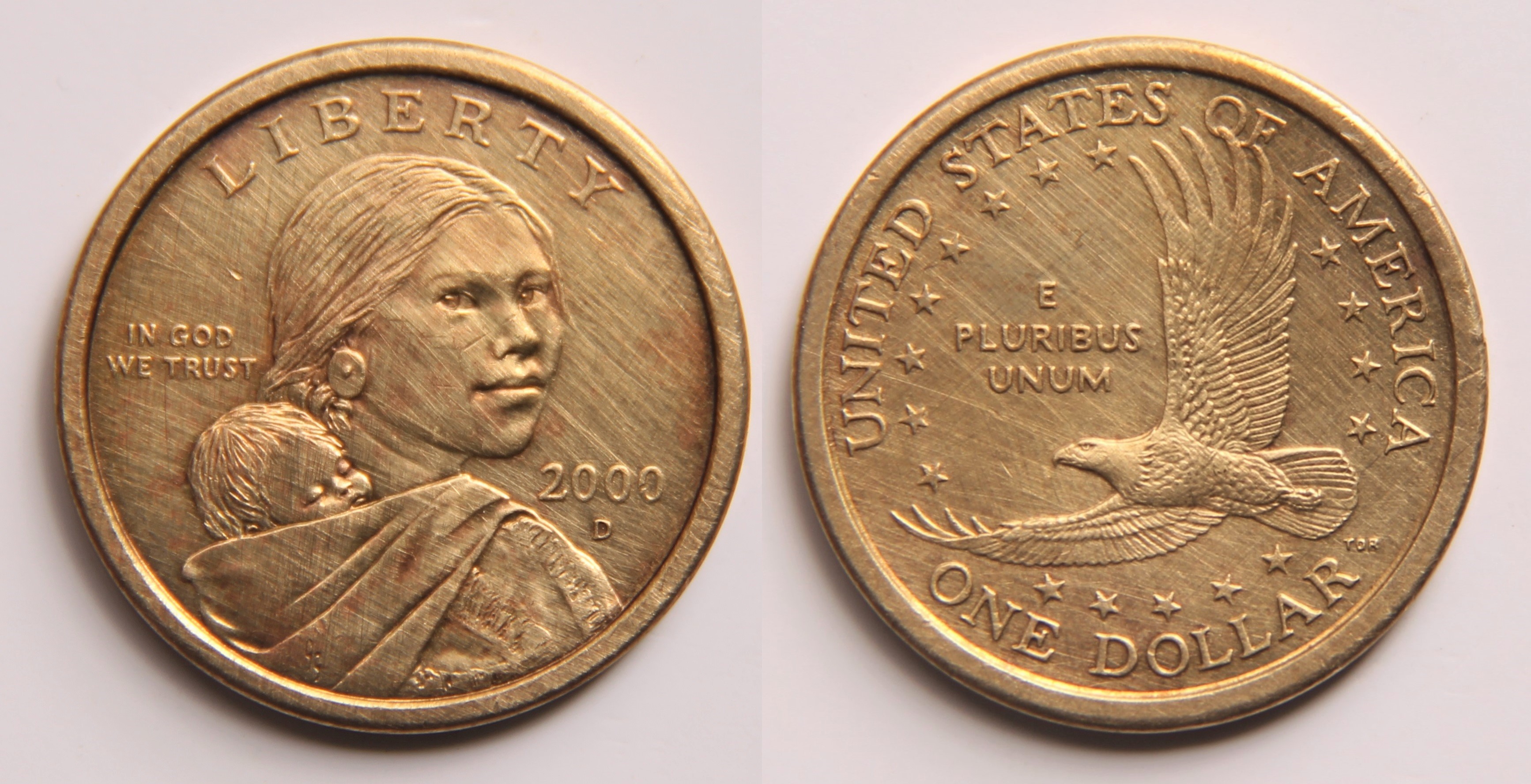

After the final days of Susan B. Anthony Dollars, a new coin emerged with a surprising twist – it was a dollar coin with a Golden color that is a result of years of planning, research, and deliberation. Years of downplaying what was known as a “coin failure”, the Anthony Dollars was succeeded by a dollar coin with a reeded edge and is made up of Copper, Zinc, Manganese, and Nickel. It first appeared in the year 2000 and was called the Sacagawea Dollar or the Golden Dollar.
Coin collectors and enthusiasts alike rejoiced upon learning about the birth of the Sacagawea Dollar – a new $1 coin to add to their collection. By the year 2009, the excitement skyrocketed after a new series was issued – Sacagawea Dollars with a new design on the reverse. It has a rich history and the portrait on the Sacagawea Dollar makes it a great collection for for coin enthusiasts and collectors alike.
The History of the Sacagawea Dollar
A report made by the Research Triangle Institute concluded that a new coin is in order. During one of their research, they came to a conclusion that although dollar bills are more convenient to use thanks to its weight and the barely there space it occupies, coins are still a much better choice. Paper bills are not only too prone to damages – these only have a lifespan of 18 months as opposed to that of a coin – which was 25-30 years.
This research report made its way to the Congress, and the next year, the Anthony Dollar was born. However, the idea of coinage did not settle with the public, and eventually chose the familiar paper money instead of the dollar coin.
Years have passed and the idea of minting a new coin resurfaced. A legislation was signed on December 1, 1997, by President Bill Clinton known as the United States Dollar Coin Act of 1997. The said Act authorized the creation of a new dollar coin to replace the Susan Anthony Dollar Coin without making the same mistake that caused the failure of the Anthony Dollar. The coin was meant to be visibly distinct – something that won’t resemble the quarter so as not to confuse the public.
Sacagawea was chosen as the main design of the coin. The young female was a Shoshone Indian who assisted the expedition of Lewis and Clark. She was only fifteen years old and is pregnant at the time she and her husband, Toussaint Charbonneau were employed by the two adventurers to guide them through the Great Plains going to the Pacific Ocean and then making their way back home.
Her great contributions were far greater than guiding the expedition and acting as their translator to do trades, but she was also able to provide the much-needed knowledge her companions needed to survive the trip. She also safely recovered the journals that recorded their travel even while her baby was strapped on her back, and was able to negotiate with Native Americans – eventually letting them go home with no casualties.
With more than enough reasons to honor her and her name, she was chosen as the face of the new dollar coin. The problem is, there was no portrait that the US Mint can use for the coin, so they made use of Randy’L Teton’s features, an Indian who came from the same tribe as Sacagawea.
The Sacagawea Dollar’s obverse was designed by Glenna Goodacre – a sculptor from New Mexico. His initials GG can be found on Sacagawea ‘s shawl. The reverse, on the other hand, was designed by Thomas D. Rogers, Sr., US Mint Engraver, and Sculptor. His reverse features an American Eagle and his initials TDR appears on the Eagle’s tail.
The Sacagawea Dollars were minted in three US Mints – Philadelphia and Denver Mints struck coins intended for circulation while the San Francisco Mint produced proofs, although a single issue was produced in the West Point Mint where 22 karats Gold Sacagawea Dollars (Proof) were minted. These were issued in March 2000 and was met with mixed reviews.
The new Sacagawea Dollar was advertised through televisions, but only coin collectors were educated enough to know that the so-called Golden Dollars were not made of Gold. Since these were made up of Copper, Nickel, Zinc and Manganese, the color of the coin changed from a Golden color to a dark mustard overtime.
By 2009, Sacagawea Dollar Coins were minted with various designs on the reverse. The reason is to honor different Native Americans.
The Detailed Specifications of the Sacagawea Dollars
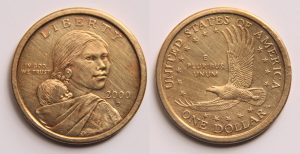
The Sacagawea Dollar has an outer layer made up of a Manganese-Brass which was banded with a pure copper core. The composition was 88.5% Copper, 6% Zinc, 3.5 Manganese, and 2% Nickel. It weighs about 8.10 grams, is 26.50 millimeters in diameter and has a plain edge. It has a border that looked to be unusual, giving it a medallic look.
The Sacagawea Dollar Design 2000-2008
The Obverse

The obverse was designed by Glenna Goodacre. It features a three-quarter profile of Sacagawea with large dark eyes. Strapped on her back as her infant, Jean Baptiste. The legend LIBERTY is on top of her in a form of an arc. The inscriptions IN GOD WE TRUST was inscribed on the left side of the coin while the date is on the right just below her chin and the respective mintmark where the coin was minted. Goodacre’s initials (GG) are on the lower left portion of the coin, on Sacagawea’s shawl.
The Reverse

As for the reverse, an American Eagle is seen soaring on the back of the coin and was being surrounded by seventeen stars that were strategically placed encircling the Eagle. E PLURIBUS UNUM inside the stars, located just above the head of the Eagle. The legend UNITED STATES OF AMERICA is seen in a form of an arc above the stars and Eagle while the denomination ONE DOLLAR is on the lowest part of the reverse. The initials of Thomas D. Rogers, Sr. (TDR) is seen on the right after the R in DOLLAR. This design for the reverse stayed up until 2008.
2009 Sacagawea Dollar
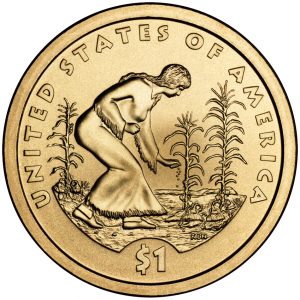
By 2009, the reverse was replaced with what was called “The Three Sisters method of planting.” The design was sculpted by Norman E. Nemeth and depicts a Native American in a field of corns, beans, and squash while planting seeds. The obverse stayed the same – with the exemption of date and mintmark which were both removed from the design. The edges from this year and the succeeding years are now lettered edges.
2010 Sacagawea Dollar
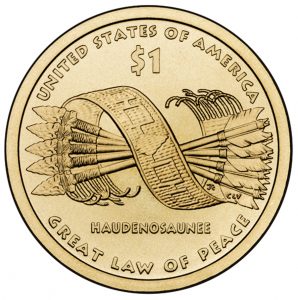
A Hiawatha Belt which was surrounded by five arrows replaced the 2009 reverse design. These depict the five confederacy nations – namely Onondaga, Mohawk, Cayuga, Oneida, and Seneca. Haudenosaunee was inscribed just below the belt and arrows while Great Law of Peace is on the lowest part of the coin. The UNITED STATES OF AMERICA is on the top portion of the reverse followed by the denomination $1. This was designed by Thomas Cleveland. CLV initials are on one of the arrows’ feathers.
2011 Sacagawea Dollar

The theme for this year’s Sacagawea Dollars was “Diplomacy – Treaties with Tribal Nations.” A peace pipe was seen which was passed on the hands of Massasoit of the Wampanoag Nation and Plymouth Bay’s settler governor. The inscription UNITED STATES OF AMERICA is still on the topmost part of the coin followed by the denomination $1. Wampanoag Treaty 1621 is written below the hands. It was designed by Richard Masters and while Joseph Menna did the sculpting.
2012 Sacagawea Dollar

The theme Trade Routes in the 17th Century was used wherein a Native American and a horse is featured in the reverse along with three horses running in the background. $1 denomination is placed below the running horses while the UNITED STATES OF AMERICA was strategically placed in a form of an arc above the horse. This was designed by Thomas Cleveland and sculpted by Phebe Hemphill. From this year onwards, all Sacagawea Dollar produced are only made and distributed among collectors.
2013 Sacagawea Dollar
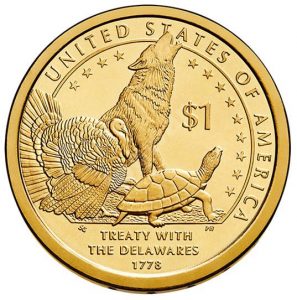
Susan Gamble designed the reverse of the 2013 Sacagawea Dollar. It features a turkey, turtle and a howling wolf – a symbolism for the tribe in Delaware. In the level of the wolf’s chest lies the denomination $1 and the three animals were surrounded by an arc of stars. The UNITED STATES OF AMERICA was position on the top of the stars while Treaty With The Delawares and the date was below the animals.
2014 Sacagawea Dollar
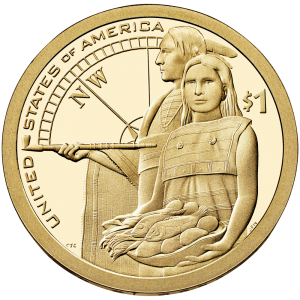
This 2014 Sacagawea Dollar features a male Native American holding a ceremonial pipe and a female, her wife was holding a plate of crops. William Clark’s compass is seen in the background displaying the word NW (northwest). The inscription UNITED STATES OF AMERICA is on an arc on the left side of the coin while the denomination $1 is on the right.
2015 Sacagawea Dollar

Phebe Hemphill engraved the design made by Ronald D. Sanders on the reverse. A Mohawk high iron worker is depicted while reaching for a swinging I-beam. The city’s skyline is pictured on an elevated view and the inscriptions Mohawk Ironworkers below it. UNITED STATES OF AMERICA is inscribed on top while the denomination $1 is in between the bean and skyline.
2016 Sacagawea Dollar
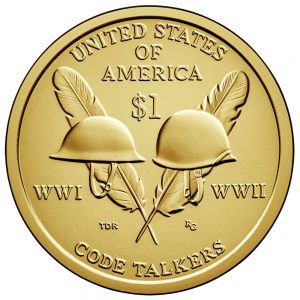
Thomas D. Rogers Sr. designed a reverse with two soldier helmets and feathers behind each are strategically placed to form the letter V. Rogers Sr.’s initials TDR just below the left helmet and feather, WWI on the far left and WWII on the far right. The UNITED STATES OF AMERICA and $1 is on top of the coin while CODE TALKERS on the lowest part of the reverse.
2017 Sacagawea Dollar
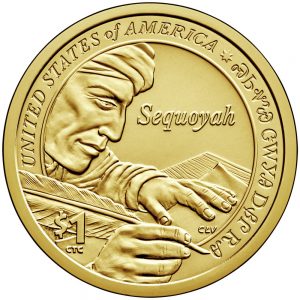
Chris Costello designed the reverse while Charles L. Vickers sculpted it. A Native American is seen writing with a feather pen and the word Sequoyah placed next to his face. The legend UNITED STATES OF AMERICA and Sequoyah from Cherokee Nation written in syllabary are on the top of the coin. $1 and initials CTC are on the lower side of the coin near the feather pen.
2018 Sacagawea Dollar
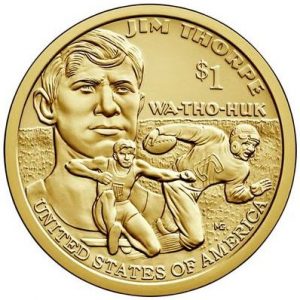
Jim Thorpe was depicted showing his Olympic and Football achievements. His name HIM THORPE is on the top of the coin in a form of an arc, followed by $1 and WA-THO-HUK and the UNITED STATES OF AMERICA situated on the lowest portion of the coin. This was designed by Michael Gaudioso.
The Sacagawea Dollars can be classified into two:
- Sacagawea Dollar (2000-2008)
This has the original obverse and reverse designs. It has coins struck in regulars strikes, proofs, and special strikes.
Regular Strikes
2000-P Sacagawea Dollar – a total of 767,140,000 pieces were minted at the Philadelphia Mint with the following variants
2000-P Mule w/State 25C Obv
2000-P “Cheerios” Dollar
2000-P Wounded Eagle
2000-D Sacagawea Dollar – a total of 518,916,000 coins were minted at the Denver Mint with the following variant
2000-D Millennium Set
2001-P – a total of 62,468,000 pieces were minted at the Philadelphia Mint
2001-D – a total of 70,939,500 pieces were minted at the Denver Mint
2002-P – a total of 3,865,610 pieces were minted at the Philadelphia Mint
2002-D – a total of 3,732,000 pieces were minted at the Denver Mint
2003-P – a total of 3,080,000 pieces were minted at the Philadelphia Mint
2003-D – a total of 3,080,000 pieces were minted at the Denver Mint
2004-P – a total of 2,660,000 pieces were minted at the Philadelphia Mint
2004-D – a total of 2,660,000 pieces were minted at the Denver Mint
2005-P – a total of 2,525,000 pieces were minted at the Philadelphia Mint
2005-D – a total of 2,520,000 pieces were minted at the Denver Mint
2006-P – a total of 4,900,000 pieces were minted at the Philadelphia Mint
2006-D – a total of 2,800,000 pieces were minted at the Denver Mint
2007-P – a total of 3,640,000 pieces were minted at the Philadelphia Mint
2007-D – a total of 3,920,000 with the following variant
2007-D Edge Lettering
2008-P – a total of 1,820,000 pieces were minted at the Philadelphia Mint
2008-D – a total of 14,840,000 pieces were minted at the Denver Mint
Proofs
2000-S – a total of 3,082,483 pieces were minted at the San Francisco Mint
2000-W 22kt Gold – a total of 39 pieces were minted at the West Point Mint
2001-S – a total of 3,184,606 pieces were minted at the San Francisco Mint
2002-S – a total of 3,211,995 pieces were minted at the San Francisco Mint
2003-S – a total of 3,298,439 pieces were minted at the San Francisco Mint
2004-S – a total of 2,985,000 pieces were minted at the San Francisco Mint
2005-S – a total of 3,300,000 pieces were minted at the San Francisco Mint
2006-S – a total of 3,054,436 pieces were minted at the San Francisco Mint
2007-S – a total of 2,062,793 pieces were minted at the San Francisco Mint
2008-S – mintage not available
Special Strikes
2000-P Goodacre Presentation
2005-P Satin Finish
2005-D Satin Finish
2006-P Satin Finish
2006-D Satin Finish
2007-P Satin Finish
2007-D Satin Finish
2008-P Satin Finish
2008-D Satin Finish
(2010) Native American, Missing Edge Lettering, Satin Finish
- Native American Sacagawea Dollar (2009 to date)
After 2008, the obverse was stripped of the date and mintmark and every year starting 2009, a new design is used for the reverse. Cons were struck in regular strikes, proofs, and special strikes.
Regular Strikes
2009 Native American, Missing Edge Lettering
2009-P Native American, Position A
2009-P Native American, Position B
2009-D Native American, Position A
2009-D Native American, Position B
2010-P Native American, Position A
2010-D Native American, Position A
2010-P Native American, Position B
2010-D Native American, Position B
2011-P Native American, Position A
2011-P Weak Edge Lettering
2011-D Native American, Position A
2011-P Native American, Position B
2011-D Native American, Position B
2012-P Native American, Position A
2012-D Native American, Position A
2012-P Native American, Position B
2012-D Native American, Position B
2013-P Treaty with the Delawares, Position A
2013-D Treaty with the Delawares, Position A
2013-P Treaty with the Delawares, Position B
2013-D Treaty with the Delawares, Position B
2014-P Native American, Position A
2014-P Native American, Position B
2014-D Native American, Position A
2014-D Native American, Position B
2014-D Native American Enhanced
Proofs
2009-S Native American
2010-S Native American
2014-S Native American
2011-S Native American
2012-S Native American
2013-S Native American
Special Strikes
(2009) Native American, Missing Edge Lettering, Satin Finish
2009-P Native American, Position A, Satin Finish
2009-P Native American, Position B, Satin Finish
2009-D Native American, Position A, Satin Finish
2009-D Native American, Position B, Satin Finish
2010-P Native American, Position A, Satin Finish
2010-D Native American, Position A, Satin Finish
2010-P Native American, Position B, Satin Finish
2010-D Native American, Position B, Satin Finish
Collecting Sacagawea Dollars
No one can deny that Sacagawea Dollar coins are beautiful coins worthy of collecting. There are rarities and errors sought-after by coin collectors.
The following are the rarities or key dates when it comes to collecting Sacagawea Dollar Coins.
2000-P Cheerios Dollars
When the US Mint started to mint the Sacagawea Dollars, they gave away some of these in boxes of Cheerios that were specially marked by the US Mint. It was only when regular issued Sacagawea Dollars were issued that people started to notice the difference between the two. The rare issues placed on the specially marked Cheerios boxes have crisp and sharp details on the tail feathers of the Eagle while the regular issued Sacagawea Dollars have tail feathers that were not enhanced.
2000-P Goodacre Presentation Specimens
This special strike coin was given a proof or specimen-like look after these were struck on burnished plankets.no one is reported to have a collection of this specimen.
2000-P Wounded Eagle Die Variety
The die used in this variety has three raised die flaws which resulted in a cut on the Eagle’s wing and torso. The exact cause of the flaw hasn’t been pinpointed but it was reported that less than 200 were minted with this error.
2007 Sacagawea Dollar with Edge Lettering
When the US Mint began issuing Presidential Dollars, some Sacagawea Dollars were minted with edge lettering instead of the plain one. It was only in the year 2009 that the Sacagawea Dollar adapted the edge lettering. One should be vigilant if you happen to stumble on 2007 Sacagawea Dollars with edge lettering as these can be easily manipulated. Authentication is needed to make sure you get an original instead of the fabricated 2007 Sacagawea Dollar with edge lettering.
One can buy PCGS-graded Sacagawea Dollars starting $1.00 up to $12,500.00 for Regular Strikes while Proofs can range from $4.00-$40.00. As for Special Strike Sacagawea Dollars, the price can range between $2.00-$8,000.00.
References:
PCGS, PCGS Coin Facts, NGC Coin, Coin Facts, My Coin Guides
